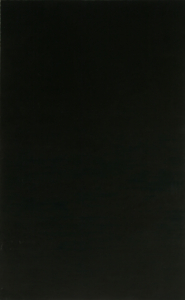Viewing art is self-reflection. As much as the artist is present in the creation process, when the art hangs on a museum wall, it belongs to the audience. We the audience craft our own narratives around this art, make assumptions about the artist or judgments based on expectations. Through this process of viewing, we focus on how we interact with the world every day. Does the artist affect how you read the work? Does the artist’s race, gender, sexual orientation, or history matter to you or do you simply read what is in front of you? If it does matter, does it matter more or less than the physical artwork? How you process artwork can be a telling look at how you view the world outside of the art museum.
Often the artwork that allows for the least direct interpretation will be the first that we pile our prejudices and beliefs on. A great example of this is Molly Vidor’s Untitled (Prussian Blue): a simple black rectangle with varying warmth and coolness forms a rough horizontal pattern on the canvas.
While looking at the image, the sheen of the oil paint can act as a mirror in some places, showing your silhouette in the dark paint. To avoid yourself, you must walk around the image, chasing that which is hidden under the shining reflections where the impression of the paintbrush catches the light. This makes the piece a more active viewing experience as you constantly dodge your shadow to see a clearer view of the image.

There is a plethora of ways to read this painting. A painter might recognize their friend Prussian Blue mixed with its chromatic counterpart Burnt Siena. Perhaps the paint reminds a viewer of a burst ballpoint pen with its sticky texture.
A sculptor might be interested in the artwork as a three-dimensional object, with its door-shaped frame hanging off the wall, one large step off the ground. The painting challenges human proportions—daunting at over six feet tall, seeming to tower above the viewer.
The sides of the painting are smudged with blue fingerprints, perhaps prompting a discussion about the humanity of the artist. Or maybe your mind goes to the contrast between the studio space and the gallery—the mess and chaos of creation is in opposition to the clean and blank museum wall.
Perhaps you have all of these thoughts together. Or perhaps none of them. Maybe you have a different understanding of Vidor’s work altogether. The analysis of the artwork itself is a telling insight into how you enjoy art. It is a reflection of what ideas you find valuable in any given piece.
Pictures do not do the artwork justice—just another part of its beauty. You cannot take satisfactory pictures of Vidor’s painting. The piece is one that must be experienced in person. Living in an increasingly digital age, the importance of viewing art in physical spaces becomes more apparent everyday. Viewing artworks like Untitled (Prussian Blue) emphasizes the importance of art as a means of mediation or self-reflection. The artwork does not allow for easy access. It is only with time, patience, and understanding that the beauty of this near-black rectangle is realized. The image demands your attention, imploring you to unpack its nuances and reveal how its valuable depths overlap with your own reflections.
Art that delivers its message using more abstract methods brings to light the inherent differences between people’s perceptions of the world. We tend to believe that others see what we see when looking at art, but we each bring our own experiences to an image. More detailed, less ambiguous art often distracts from these differences in how we fundamentally perceive images. Given less distinct information, we are forced to assess how exactly we fill in the gaps. When there is a lack of definition or understanding, we fill those gaps with what comes naturally. What comes naturally is vastly different for each of us and is tangled up with everything about who we are.
Molly Vidor’s Untitled (Prussian Blue) is now on view as part of Painting Deconstructed, Selections from the Northwest Collection, now on extended view at Tacoma Art Museum. Explore Painting Deconstructed here and view Molly Vidor’s work on eMuseum.
Source: Tacoma Art Museum

Recent Comments